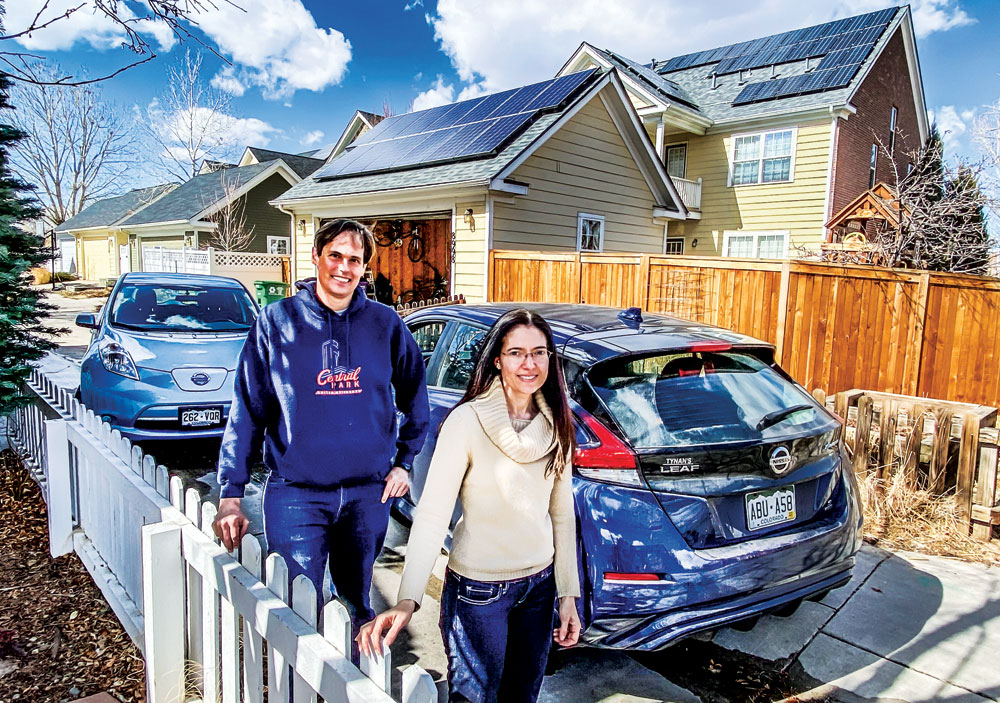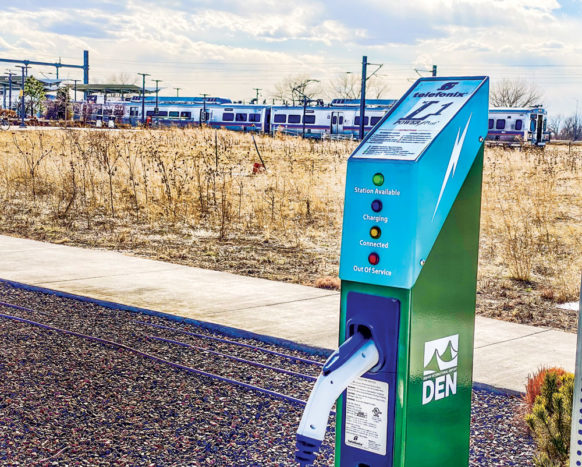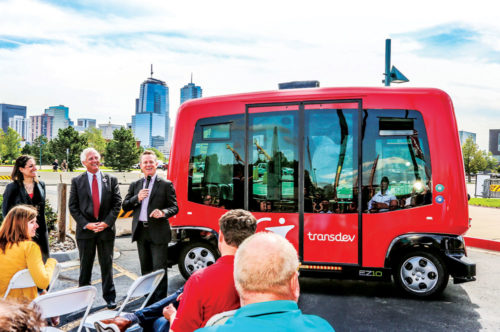
With two Nissan Leaf electric vehicles and solar panels on their home, Mark Mehringer and Jessica Bordy have significantly reduced their emissions.
Until recently, most Americans seemed to think of electric vehicles (EVs) as something out there in the future. But as sports fans watched Will Ferrell attempt a Norway trip to see all the EVs in that country, the point of the Super Bowl ad was clear—EVs are not futurist anymore, they’re everyday American cars. “Customers who had never considered buying an EV, after driving one as a loaner during the repair of their gas-powered vehicle, are suddenly talking about getting an EV for their next vehicle,” says General Manager Matt Marr at Fowler Chevy.

61st and Peña Station (left) and the Central Park Station are the only RTD stations with electric vehicle chargers, though RTD has designed several Park-n-Ride locations that are EV ready (conduit has been placed or space is available for conduit in the future). Central Park Station is RTD’s pilot program for EV technology and has the capacity to expand from two to six chargers there. Before the pandemic RTD was providing about 1,000 charging sessions per year. During the pandemic year that fell to 250.
Central Park resident and Leaf-owner, Mark Mehringer, who hosted an EV forum as part of Central Park United Neighbors’ (CPUN’s) sustainability program, says the benefits of owning an EV far outweigh the drawbacks—they’re cleaner, quieter, overall cheaper, and they offer quick acceleration. An additional benefit in cold weather, he adds, is that the electric heater warms up much faster than a gas engine heater—and has no emissions when you have to sit and wait in your car and need the heater on.
Brad Revare, also a Central Park resident, says sticker shock and range anxiety aren’t the obstacles they used to be. He’s in line to buy Volkswagen’s SUV, the ID.4 which starts at $39,995. He calls that a bargain considering Tesla’s comparable model is north of $80k. “It’s the most price-accessible electric SUV that’s out there right now,” says Revare. “And when you factor in the federal and state tax credits, gas savings, and fewer maintenance costs, it feels like the right time.” He calls range-anxiety more “mental than a real-world problem.” And says, “For 98 percent of your trips, there is no worry, but if you want to go up to the mountains in Colorado or on a road trip somewhere, you have to make sure there are enough chargers on the way, so you don’t get stranded. You have to do a little more research to make sure you can make it. I don’t think the tipping point [for most people] isn’t about the cars; it’s about the chargers.” Revare’s tipping point was “doing right” by his almost-2-year-old daughter, Hema. He says, “One day the next generation will judge us on what we did to combat climate change.” Going electric will be his answer.

Brad Revare, pictured with 2-year-old Hema, appreciates being able to go farther and faster, particularly uphill, without getting hot and sweaty (especially when riding to work). And, he says, “It’s just flat out fun to ride.” With the e-bike, his family downsized to one car, saving money and lowering their carbon footprint.
For short trips, e-bike users express just as much enthusiasm about their vehicle as EV drivers. Central Park resident Shalon Bowens rides her new, tomato-red e-bike everywhere—to King Soopers and to her job as a Program Manager at It Takes a Village, a sexual health clinic. Bowens, who’s lost 70 pounds since adopting her e-bike last year, says it isn’t just about getting from point A to point B. Riding a bike has changed her whole perspective. “I pull over and see things now. I notice things I’ve never noticed before.” It’s that refreshing experience that helps fuel her for tough days at the office, helps keep her focused on the hope instead of the hardships.“There’s so much anxiety right now, people worried about making rent, ending up homeless. Riding my e-bike takes all that away because I’m free.”

Revare says e-bikes “are just flat-out fun to ride,” and the e-bike turned out to be very cost-effective for his family when they decided they could downsize to one car.
Bowens received her free e-bike through a pilot program called Can Do Colorado Community Challenge. The program, which awarded 13 e-bikes to low-income essential workers, was part an initiative to help Coloradans return to work post-COVID-shutdown, as well as part of Colorado’s ambitious plan to combat climate change. Will Toor, the Director of the Colorado Energy Office, said in a Colorado Public Radio article that the second e-bike giveaway, which will also include the City of Denver and the Regional Air Quality Council, will award more than a 100 new e-bikes. “I think there is significant potential over time for e-bikes to play a really important role in replacing a lot of those short-to-medium distance automobile trips,” he said. And e-bikes are only a small part of the going green equation.
In the fifteen years since Tesla announced its plan to produce a luxury electric sports car, the electric vehicle (EV) industry has both accelerated—there are 27 new EVs on the market today—and remained idle. EVs account for only two percent of vehicles sold in the US. But new legislation may be just the fuel to finally push the EV revolution into overdrive. President Biden, signed an executive order to electrify all 645,047 vehicles in the federal fleet, making the U.S. government the auto industry’s top consumer.
The federal government isn’t the only one pushing the EV revolution. Forty-five states and the District of Columbia provide incentives for certain EVs including: tax credits and rebates, exemptions from emissions testing, and utility-rate reductions. California, New Jersey, and Massachusetts have made it illegal to sell new gas-powered vehicles after 2035.
Colorado’s current EV plan for a large-scale transition of Colorado’s transportation system to zero emission vehicles relies on Xcel’s Transportation Electrification Plan (TEP). Xcel’s TEP programs are designed to help customers overcome cost barriers to EV adoption, to increase awareness of EVs and their benefits, and to encourage vehicle charging during low-cost times. The City and County of Denver—also reliant on TEP—aims for an 80 percent reduction in greenhouse gas emissions by 2050 with a 100 percent of light-duty vehicles being electric that same year.
“20 or 30 years from now, Americans’ mass adoption of electric vehicles will seem like something that was always going to happen. I can tell you, from where I’m sitting, it’s never felt inevitable before. It feels inevitable now,” writes Robinson Meyer in a February 7 article in The Atlantic.
Coming in the future?
 In August 2017, then-RTD General Manager Dave Genova (with mike) and the manufacturer of the EZ10 driverless vehicle offered demonstration rides to the public in the Pepsi Center parking lot.
In August 2017, then-RTD General Manager Dave Genova (with mike) and the manufacturer of the EZ10 driverless vehicle offered demonstration rides to the public in the Pepsi Center parking lot.
In January 2019, RTD launched a six-month demonstration project with an autonomous vehicle (AV) shuttle at the 61st and Peña commuter rail station.The project’s main goal was to assess the viability of autonomous services in providing first and last mile connections to and from transit. It was the first on-road deployment of an AV shuttle in Denver or in Colorado.
Some service disruptions did occur due to snow and heavy rain, and his first generation vehicle lacked of heating and had a limited battery range, issues addressed in subsequent generations of the vehicle.
RTD os in the early stages of potential automated shuttle pilot projects in two locations: the Denver Technology Center and the Colorado School of Mines. No further info is available at this time.
Front Porch photos by Steve Larson


I would like to make a comment on the article “The Electric Revolution Is Here” in your April 2021 edition of the Front Porch publication.
As much as I appreciate reading articles on the EV Revolution I think they should be researched for valid facts and not just opinions.
A resident of Central Park, Brad Revare, was quoted saying “Sticker shock and range anxiety aren’t the obstacles they used to be” and I agree with that.
The article goes on to say “He’s in line to buy Volkswagen’s SUV, the ID.4 which starts at $39,995. He calls that a bargain considering Tesla’s comparable model is north of $80k.”
The comparison is totally incorrect in that it should be made to the Tesla Model Y that has a starting price of the same $39,995. The $80K+ is for the Model S Tesla which is a Sedan and not an SUV.
He also is quoted as saying “It’s the most price accessible electric SUV that’s out there right now.” I think the VW ID.4 is a good EV but his statement is just not true. There are too many models to mention but a few are the KIA Niro EV starting at $39.090, Hyundai Kona starting at $37,390 and the Chevy Bolt starting at $36.620. All currently available in the U.S.
Putting out misinformation is not going to help the EV Revolution. We need to help clarify and not confuse the consumers!
Thanks in advance,
Jim Kelly